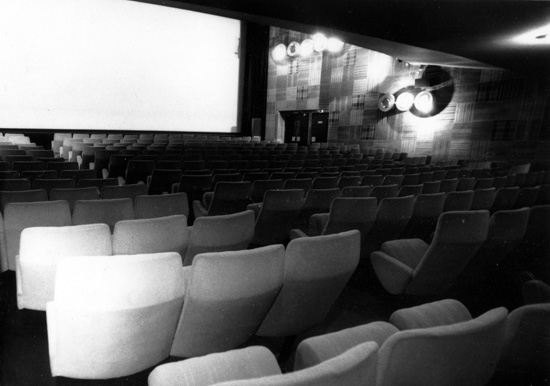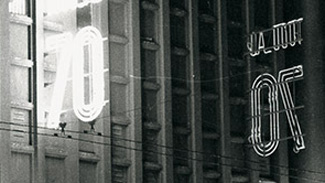70mm in Lyon, France |
Read more at in70mm.com The 70mm Newsletter |
| Written and photographed in part by: Jean Noel Durand Bourat. This article is mostly based on my personal memories as very little literature exists on the subject; I hope some readers will be able to provide further information and corrections wherever needed. | Date:
03.03.2018 Updated 22-01-25 |
 Photo
credit: Bibliothèque Municipale de Lyon under creative Common licence Photo
credit: Bibliothèque Municipale de Lyon under creative Common licence Lyon, France is known as the birth-place of the Cinematograph and of its inventors the Lumiere Brothers who also developed a 75mm camera and projector to be used for large-hall film exhibition at the 1900 World Fair in Paris. Lyon used to have up to 7 venues with 70mm capability. • Le Comoedia (Open as a 9 plex cinema showing art-house movies) • Le Star (now a furniture store) • La Scala (closed and vacant) • Le Festival (now a home-cinema show-room and private auditorium) • Le Tivoli (now a store) • Le Cinéjournal (now a fashion store) • Le Palais Des Congres |
More in 70mm reading: Le Format 70mm A Lyon France The Palais Des Congres, Lyon, France Le Palais Des Congres A Lyon, France DP70s in France 70mm Cinema and Film in France in70mm.com's Library Presented on the big screen in 7OMM Peripheral Vision, Scopes, Dimensions and Panoramas |
The COMOEDIA |
|
 Photo
credit: Bibliothèque Municipale de Lyon under creative Common licence Photo
credit: Bibliothèque Municipale de Lyon under creative Common licence Le Comoedia was destroyed by war action in 1945. Rebuilt as a modern cinema in the 1950s it was perfectly adapted to the implementation of Todd-AO and was the first to be in Lyon and one of the first in France. The conversion proved a tremendous success story I have already told on this site. I just want to add that it is now a thriving art-house multiplex recently extended with three state of the art auditoria. The nine screens are digital but the three largest have retained 35mm Simplex Millenium projectors. The two giant screens inherited from the 70mm era have survived, one of them has been widened to the scope ratio by removing the tabs. It's a pity no 70mm projector has been reinstated. |
|
FILMS PRESENTED IN 70MM AT THE COMOEDIA |
|
 Le Comoedia
in Lyon. Image by Jean Noel Durand Bourat Le Comoedia
in Lyon. Image by Jean Noel Durand BouratThe expression "Blow-up" is applied to films projected in 70mm but filmed in in 35mm. The mention "CP200" means that the film is presented in Dolby Stereo magnetic multi-track sound: • South Pacific • The Miracle of Todd-AO. Film de démo présenté en complément de South Pacific • Porgy and Bess • Ben Hur • Can Can • Spartacus • The Alamo • Exodus • King of Kings • West Side Story • El Cid • Mutiny on the Bounty • Lawrence of Arabia • Cleopatre • Cheyenne Autumn (les Cheyennes) • Lord Jim • The Sound of Music (La Mélodie du Bonheur) • Uncle Tom’s Cabin (La Case de l'oncle Tom) • The Agony and the Ecstasy (L'extase et l'Agonie) • Doctor Zhivago (BLOW-UP) • Play Time (1,85 / 5 track magnetic sound) • Doctor Dolittle • Gone with the Wind (BLOW-UP) (Autant en Emporte le vent) • 2001: A Space Odyssey • Hello, Dolly! • Where Eagles Dare (BLOW-UP) (Quand les Aigles Attaquent) • Ryan’s Daughter (La Fille de Ryan) • The Shoes of the Fisherman (BLOW-UP) • The Longest day (BLOW-UP) • Tora Tora Tora (BLOW-UP) • That’s Entertainment (BLOW-UP / 1,85) • Close Encounters of the Third Kind (BLOW-UP)(Rencontres du Troisième Type) • E.T. (BLOW-UP / CP200 / 1,85) • 2010 Odyssey 2 (BLOW-UP / CP200) • Out of Africa (BLOW-UP / CP200 /1,85) (Souvenirs d'Afrique) • Silverado (BLOW-UP / CP200) • Rambo First Blood Part 2 (BLOW-UP / CP200) • Aliens (BLOW-UP / CP200 / 1,85) • Batman (BLOW-UP / CP200 / 1,85) • The Abyss (BLOW-UP / CP200) • Go to Chronological premiere list of all 70mm films • Go to Large Format 7OMM Engagements |
|
The STAR |
|
 The CINEJOURNAL.
Photo credit: Jean-Noel DURAND BOURAT The CINEJOURNAL.
Photo credit: Jean-Noel DURAND BOURATLe Star was built in 1957 in premises that were hardly suitable for cinema showing. Attendances failed to meet expectations and various attempts were made at attracting more spectators. One of them was a 70mm conversion which also proved a failure probably because the geometry of the place made it impossible to extend the size of a screen that was too small even for 35mm. Only one or two films had short runs in 70 mm and I am sorry to say I do not have the titles in mind. |
|
The SCALA |
|
|
La Scala was a former music hall which was totally rebuilt as a lavish
magnificent cinema in the middle 50s. It featured two balconies and was
provided with excellent stereophonic sound including Perspecta. The
Cinemascope screen was large but far from being from wall-to-wall. When two of
the three Simplex XL projectors were replaced by two
DP70s in the '60s the screen
was not extended, probably the reason why "Is Paris Burning?", the one
and only 70mm release, wasn't even advertised as such. |
|
The FESTIVAL |
|
|
Le Festival was a comparatively small cinema with a long and narrow
auditorium whose width was approximately 6 metres, far from the ideal place
to install 70mm. Yet "Krakatoa East of Java" and "Custer of the West"
premiered there advertised as Super Cinerama and projected with Victoria 10
projectors on a postcard sized screen. How strange! |
|
The CINEJOURNAL |
|
 Photo
credit: Jean-Noel DURAND BOURAT Photo
credit: Jean-Noel DURAND BOURATLe Cinéjournal opened in 1936 as a news theater. In 1956 the cinema was totally remodelled to accommodate a wall-to-wall 10 metre wide CinemaScope screen. The side walls and ceiling were fitted with special acoustic materials with built-in concealed surround speakers. The booth was provided with a pair of XL Simplex projectors featuring magnetic sound readers connected to an Altec Lansing 4-track valve amplifier. Such a sound system delivered an amazing stereophonic sound enhanced by the perfect acoustics of the room. A brand new Hertner AC/DC converter allowed to boost the Peerless arc lamphouses to the 50 amps required by the lavish Walker Silverscreen. Special non reflecting mobile masking with automatic stops for the various aspect ratios gave the illusion that pictures widened or narrowed progressively, a unique feature in Lyon. In the 1960s 70mm was considered and the screen size was increased in height, up to the ceiling, to reach the 2,21:1 70mm aspect ratio. But the DP70s had to wait in their crate until the triplexing of the cinema in 1976. One was in booth #1 serving the upper auditorium that had retained the original stereophonic sound system with 4-tracks only. The 2nd machine served the lower left auditorium. The full benefit of the DP70 was utilized only twice for re-runs of "Around the World in 80 Days" in Todd-AO and of "55 Days at Peking" in Super Technirama 70. Although only with four channels, this sound was just extraordinary. The mag reader was also used for a pair of 35mm stereophonic releases: "Saturday Night Fever" and "Shock of the Titans" (1st version). |
|
The TIVOLI |
|
 .
Photo credit: Jean-Noel DURAND BOURAT .
Photo credit: Jean-Noel DURAND BOURATLe Tivoli was one of the oldest cinemas in Lyon dating back to the Silent era. When it was deeply remodelled in the middle sixties the idea was to rival the Comoedia. And it did in terms of wall-to-wall 70mm screen size and 6-track stereophonic sound. Moreover the decoration had a touch of luxury. The only problem was that not a single 70mm first run was held. There were only a few revivals in Super Technirama 70 namely "El Cid" and "La Fayette" which had both only been released in 35mm before. To complete the list I should add "The Longest Day" and the original "Star Wars" trilogy, but these films had premiered in 70mm either at the Comoedia or the Palais Des Congres. The scarcity of the 70mm showings was all the more regrettable that both vision and sound were just amazing. It is to be noted that the booth had originally retained an antiquated Gaumont projector to the side of the brand new DP70s. When the cinema was 4-plexed the original auditorium retained its giant screen and pair of DP70s. But the need for automation led to the implementation of two Victoria 8 «rock and roll» projectors. As a result their 70mm neighbours only ran in special occasions when mag sound was needed. |
|
The Palais Des Congres |
|
 The Palais Des Congres was built in 1961 in the brutalist style. It was the work of architect Marcel Salagnac. The venue was not intended to be used only as a Convention Centre. The “grand auditorium” originally seating 1200 was also purpose built to accommodate live entertainment on a very large stage as well as 70 mm films shown on a 22x10 metres flyable screen that filled the full proscenium arch. The opening film was “Barabas” in Super Technirama 70 followed by “My Fair Lady” in Super Panavison 70 • Go to Le Palais Des Congres A Lyon, France (FR) • Go to The Palais Des Congres, Lyon, France (UK) |
|
 • Go to Le Format 70mm A Lyon France • Go to 70mm in Lyon, France |
|
 • Go to Le Format 70mm A Lyon France • Go to 70mm in Lyon, France |
|
| Go: back - top - back issues - news index Updated 22-01-25 |
